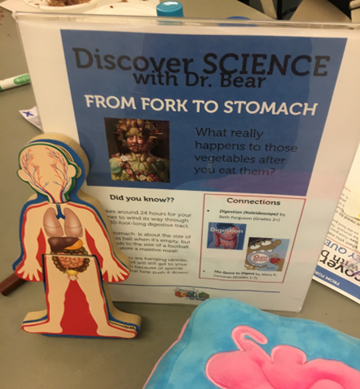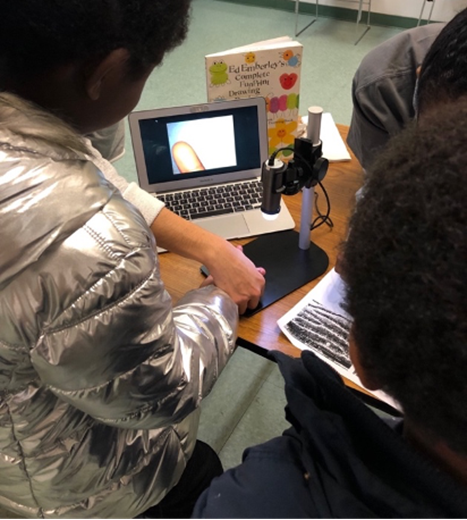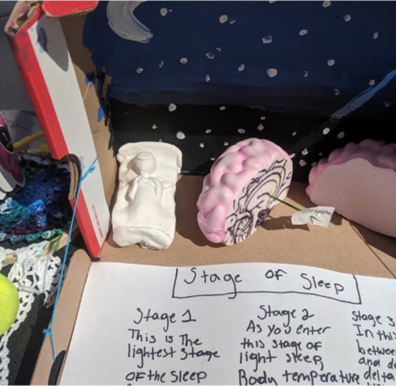Breaking Racial Barriers in Health and STEM Education
A new model of STEM learning offers possibilities for improving access to scientific and medical careers among children in underserved communities.
In the United States, racial minorities continue to face considerable barriers to participation in STEM (science, technology, engineering, and mathematics) health-related careers and professions. In 2017, a study conducted by the National Science Foundation found that Black men and women comprise 11% of the overall US workforce, but only 5% of all STEM workers across the country. Similarly, Hispanic men and women account for roughly 16% of the total US working population, and only about 6% of the nation's STEM workforce.
Decades of scholarship have demonstrated that racial biases create negative STEM experiences for minoritized communities. From an early age, kids are exposed to exclusionary messages about who belongs in science and medicine, leaving them without positive role models, and sowing self-doubt. Under-representation of racial minorities in the STEM and health fields is compounded by the fact that many children of color live in neighborhoods where schools are under-resourced, and where access to high-quality STEM and health learning opportunities is lacking. STEM professionals of color report profound imposter syndrome as they pursue a STEM or health-related careers.
As a result, the STEM and health workforce is overwhelmingly White. By not attracting the best and brightest from all of society, the United States' status as a global STEM and health leader is being undermined.
How can we promote more racially diverse STEM environments? What can be done to reverse the under-representation of racial minorities in the STEM and health professions?
Discover SCIENCE with Dr. Bear
To begin addressing these deficiencies, in 2017, a project called "Discover SCIENCE (a Scientific Creative Innovative Engaging New Cool Experience) with Dr. Bear" was launched. Born out of the Children's National Medical Center, and supported by funding from a Science Education Partnership Award (SEPA) of the National Institutes of Health (award #1R25Od023773-01), Discover SCIENCE sought to deliver high-quality STEM and health learning experiences to African-American, African, and Hispanic youth in the Washington DC and Baltimore metro areas. Discover SCIENCE developed, tested, and made freely available a collection of innovative, hands-on, art-based STEM curricula—all of which are designed to pique children's curiosities about health, science, and the human body, to promote critical thinking and scientific literacy, and to generate excitement and enthusiasm for STEM and health-related careers.
Designed specifically for use in out-of-school-time (OST) contexts, the curricula were initially tested in branches of the District of Columbia Public Library and Enoch Pratt Free Library systems. After that first wave of testing, the curricula were tested with other informal learning partners, including the Girl Scouts of Greater New York, the New York Network for Youth Success, Oregon Ask, and the Kiwanis Foundation Washington DC chapter.
Our evaluation of Discover SCIENCE revealed that the project was incredibly successful—particularly in terms of breaking racial barriers to STEM and health learning. It did this by:
- Producing a curriculum attentive to the health needs and concerns of local communities
- Making children excited about science, and helping them develop positive identifications with science
- Improving children's STEM and health-related knowledge, and helping them translate this knowledge into specific activities for preserving and promoting human health
Through the collective efforts of library staff and educators working in other informal learning settings, this new model of STEM and health learning has already reached hundreds of children across the country. In addition, the Discover SCIENCE online platform makes these tools available at no cost to anyone seeking to help break down the barriers that are preventing all children from rising to their fullest potential.
The Curriculum
STEM and health-related curricula have rarely been developed in ways that consider the needs, interests, or perspectives of racial minorities and other historically marginalized peoples. By contrast, Discover SCIENCE was informed by a Community Needs Assessment conducted in the District of Columbia, a demographically diverse area where 41% of the population identifies as Black or African American, 11% as Hispanic or Latino, and 38% as White. The assessment pinpointed six health concerns of central importance to local residents: (1) asthma; (2) nutrition; (3) bones; (4) mindfulness; (5); sleep; and (6) genetics. Each of these areas have informed the curriculum's development. Particular lessons include:
Asthma
- "An Air Affair" teaches about respiratory function
- "The Nose Knows" explains the environmental factors related to asthma
Nutrition
- "From Fork to Stomach" teaches about the digestive system
- "Let's Make Poop" teaches what happens to food in the intestines
Bones
- "Q-Tip Skeletons" teaches about human skeletal structure
- "X-Rays, Fractures, and Casts" teaches what happens when bones break, and how bones heal
Mindfulness
- "Address that Stress" teaches about how stress affects the body
- "'Reflecting' on Feelings" teaches about the power of positive affirmation
Sleep
- "Socktopus" teaches about the importance of having a bedtime routine
- "Starry Night Light" teaches about how sleep can promote health and wellbeing
Genetics
- "Blood Breakdown" teaches about the different parts of human blood
- "Print Sprint" teaches about fingerprints and genetic codes

Many of the activities contained within the above lessons speak directly to the health needs of marginalized communities. For example, a module on "Genetics and Heredity Traits" draws attention to the fact that "1 in 13 Black or African American babies is born with sickle cell trait," while also providing a link to a video ("Living with Sickle Cell Disease: Bryce's Story") highlighting one particular Black child's experience of living with this genetic disorder.
Another way Discover SCIENCE addresses local community needs is through the provision of bilingual content. Many of the curriculum's learning modules have been adopted for ESOL learners and Spanish speakers. On the project's website, a series of "Staying Safe with Drew and Nia" videos developed by Fablevision teach children about germs, mucus, sleep, blood, the digestive system, and stress in both English and Spanish.

Content such as this addresses a key part of the "STEM Pipeline Problem": language barriers that sometimes limit STEM education to native English speakers. Because it includes a significant amount of Spanish language content, the Discover SCIENCE curriculum can be used to overcome these barriers, and to ensure that learning occurs in both out-of-school time (OST) contexts and inside the home. As parents and caregivers play a strong role in children's attitudes toward science, this bilingual content is essential, as it creates ways for non-native English speakers to have family conversations around science and health-related topics.
Innovations like these are helping to create an intergenerational, community-based model of STEM and health learning. When asked about the relevance of the curriculum, one parent told us that Discover SCIENCE content was "reinforcing what I'm teaching at home." Responding to a question about their experiences participating in the project, a library worker similarly drew attention to how effectively Discover SCIENCE engaged community needs, noting that the "whole process was enlightening and challenged me to see how I can use this information and give it back to the people I work with." As these statements indicate, by taking a multicultural, racially inclusive approach to STEM and health education, Discover SCIENCE is prompting greater awareness of local health needs, and helping spread knowledge of effective means of addressing these.
Knowledge, Attitudes, and Behavior
The Discover SCIENCE curriculum was designed to promote awareness of the health inequities and disparities that exist within underserved communities. Because the curriculum's content reflected the health concerns of DC metro area residents, it was ideally positioned to help children make connections between their day-to-day experiences and the different socioeconomic, cultural, and environmental variables that contribute to poor health outcomes.
Consider the Discover SCIENCE nutrition module. From the very beginning of the project, participants noted the difficulties involved in getting children to adopt active, healthy lifestyles in places where patterns of racial segregation and socioeconomic disenfranchisement have combined to produce extensive food desserts. As a library worker explained to us during the first year of the project:
“If you are doing a nutrition piece program, be conscious of if there are families in the room. Are they in a neighborhood where they need to walk two miles to get to the nearest grocery store that has fresh fruits and vegetables?”
The members of the Discover SCIENCE leadership team were fully aware of these structural barriers to healthy living. Cognizant of the fact that many DC residents lack access to health, affordable food (click here for more on this), and that many of the children they were working with faced food security challenges, they aligned the curriculum's nutrition modules with local needs and circumstances. In lessons on nutrition, they pushed back against the toxic impacts of diet culture, stressing the dangers of labeling any food "good" or "bad." They also created and disseminated a guidebook that included links to articles and activities promoting body positivity. Along with this, some library programs included yoga sessions and mindfulness meditation, and campers at the Summer Science program learned about the importance of healthy habits—including the value of a full night's sleep, regular body scanning, hydration, and physical activity.
By grounding health literacy in real-life contexts, the library workers and facilitators who implemented the curriculum promoted awareness of the structural determinants of health and illness, engaging with the various barriers that shape children's lived experiences, and promoting realistic, culturally sensitive approaches to well-being and self-care.
Another example of this can be seen through library workers' teaching of a lesson called "The Nose Knows." Aligned with scientific studies showing how socioeconomic marginalization produces both higher rates of asthma and worse asthma outcomes for racial minorities, this lesson not only teaches children about the respiratory system, but also about allergies and asthma triggers. By asking if they or anyone they knew had asthma, and giving children an opportunity to talk about their lived experiences of health and illness, library workers were able to open discussions about how to best manage asthma and other respiratory ailments. As a result, Discover SCIENCE not only gave children a new scientific vocabulary for talking about their bodies, but also helped them craft strategies of disease prevention linked to the particular health risks and dangers they face in their day-to-day lives.
Critically, Discover SCIENCE did all of these things in a welcoming, encouraging, supportive manner. Project leaders and facilitators succeeded in creating an environment entirely free of the exclusionary stigmas and stereotypes that push people of color out of STEM and health-related professions, and as a result, children's experiences of Discover SCIENCE were overwhelmingly positive, Participating in activities with enthusiasm and excitement, they were eager to share things they learned with peers, siblings, and parents/caregivers, and greeted each new lesson with smiles, laughter, and genuine joy. Speaking to how engaged they were, one library worker told us:
“What I really liked about [Discover SCIENCE] was that the activities were very adaptable to how young the kids were. They really enjoyed the program. Nothing was too long for their attention span. I thought it was really cool!”

The joy and excitement children experienced during Discover SCIENCE activities helped them acquire more knowledge about health and science, while also deepening their critical thinking capacities. Library facilitators observed children making use of new scientific terms and concepts in conversations with peers and families. They also saw children using their newfound knowledge for "some really interesting problem-solving." After leading children through the "Socktopus" activity, for example, one facilitator reported that this exercise prompted all kinds of critical thinking about why humans dream, and what our dreams might mean for our waking lives. Children also learned new behaviors. For example, after learning about sports injuries and the effects they can have on the brain, one child said, "I learned if I am seeing double, I need to tell an adult."

As they learned more and more about health and the human body, children realized that science and medicine are enjoyable subjects they can both have fun with and succeed at. This led to the development of more positive associations with science—something researchers have highlighted as a key goal for racially inclusive STEM education. By introducing children to scientists of color, Discover SCIENCE helped break down stereotypes about who STEM belongs to. For example, after meeting a NASA scientist during the Discover SCIENCE summer camp program, one camper spoke about how she wanted to become the next Black woman astronaut. During this week-long program, campers were asked to draw pictures of scientists. Their first attempts reproduced stereotypical views about what scientists look like—for example, "Science Bob," an old White man in a lab coat with unkempt hair. But by the end of camp, children were drawing scientists that looked very much like themselves. Moreover, when asked if going to camp made them want to become scientists, most responded affirmatively, listing a number of specific fields (including anesthesiology, astronomy, geology, marine biology, medicine, paleontology, and zoology) as potential career options.
All of this helped promote a sense of belonging to STEM, and enabled children to see themselves as scientists. Given the historical and ongoing under-representation of people of color within the scientific and medical professions, this was a notable achievement.
Let's Put it to Work!
The idea behind the Discover SCIENCE project was to create a STEM and health curriculum aligned with the needs of minoritized groups. Cognizant of how race has historically functioned to prevent people of color from gaining access to scientific and biomedical fields, project leaders sought to create a more inclusive form of STEM and health education, and to create pathways for disseminating this innovative learning model throughout the country. Since its inception, Discover SCIENCE has reached hundreds of children, and our evaluation shows that this project is a step in the right direction. While much more work needs to be done in order to create a racially diverse STEM and health workforce, Discover SCIENCE certainly has the potential to help reverse the longstanding under-representation of Black and Latinx populations in scientific and medical careers. It can also contribute to reducing those health disparities borne of systemic racism and socioeconomic marginalization.
Interested in learning more about Discover SCIENCE? Want to adapt the project's learning modules to your own STEM and health literacy programming? For more on how to take advantage of the many useful resources contained with this curriculum, visit the Discover SCIENCE website, which contains lesson plans, activity guides, videos, and many other educational materials that can be used to promote children's interest in and knowledge of science and the human body.
Cover photo courtesy of Julia Beth Miller, CRI Program Staff, 2019